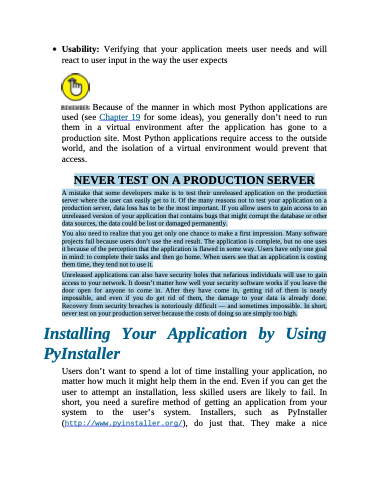Page 432 - Beginning Programming with Pyth - John Paul Mueller
P. 432
Usability: Verifying that your application meets user needs and will react to user input in the way the user expects
Because of the manner in which most Python applications are used (see Chapter 19 for some ideas), you generally don’t need to run them in a virtual environment after the application has gone to a production site. Most Python applications require access to the outside world, and the isolation of a virtual environment would prevent that access.
NEVER TEST ON A PRODUCTION SERVER
A mistake that some developers make is to test their unreleased application on the production
server where the user can easily get to it. Of the many reasons not to test your application on a
production server, data loss has to be the most important. If you allow users to gain access to an
unreleased version of your application that contains bugs that might corrupt the database or other
data sources, the data could be lost or damaged permanently.
You also need to realize that you get only one chance to make a first impression. Many software
projects fail because users don’t use the end result. The application is complete, but no one uses
it because of the perception that the application is flawed in some way. Users have only one goal
in mind: to complete their tasks and then go home. When users see that an application is costing
them time, they tend not to use it.
Unreleased applications can also have security holes that nefarious individuals will use to gain
access to your network. It doesn’t matter how well your security software works if you leave the
door open for anyone to come in. After they have come in, getting rid of them is nearly
impossible, and even if you do get rid of them, the damage to your data is already done.
Recovery from security breaches is notoriously difficult — and sometimes impossible. In short,
never test on your production server because the costs of doing so are simply too high.
Installing Your Application by Using PyInstaller
Users don’t want to spend a lot of time installing your application, no matter how much it might help them in the end. Even if you can get the user to attempt an installation, less skilled users are likely to fail. In short, you need a surefire method of getting an application from your system to the user’s system. Installers, such as PyInstaller (http://www.pyinstaller.org/), do just that. They make a nice


